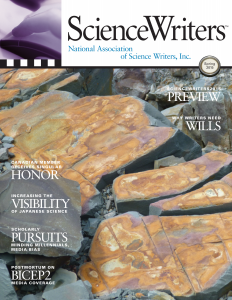By Victor McElheny
Worrying about the future these days, like all of our gang, I fear that science journalism faces a big conceptual problem. It stems from the current, probably temporary, shift of focus away from established news agencies toward a welter of freelance expression. The resulting fascination with public engagement and storytelling may obscure other things we need to think about.
In my view, regular daily and weekly journalism (including science reporting) by experienced practitioners has not been abolished, despite a couple of decades of “creative destruction.” In fact, many in our craft have adapted and are continuing to adapt to a multi-channel regime of delivering their news reports to the public. Further, the multiplication of scientific discoveries and applications inevitably boosts the number of popular expositors of these developments. Applications for the Knight Science Journalism Fellowships at MIT are about four times what they were in the 90s.It seems obvious that the Delta — the mathematical symbol for change — in our times is driven primarily by technology and science. To survive in this world, or even just cope, one has to tune into the changes in how we think and do things. Journalists, humanistic chroniclers, help us connect to the swarm of revolutions.
But the work of science exposition calls for people who make a career of it. They must have a course of development to follow, as a serial entrepreneur like George Scangos, the CEO of Biogen Idec (to choose an example from the particularly strident atmosphere of biotechnology), could tell us. Careers, accumulations of experience, imply structures with standards. And science journalists have to be more like intellectuals than most journalists. They have to stay at it longer to get good.
And their activities cost more than those of most journalists, because they involve more study, more interviews, more graphic representations of concepts than is usual in journalism. It’s all inherently expensive. There must be capital to support the work. There must be sources of a middle-aged person’s salary, so that the science journalist can avoid the usual requirement in raising a family to go to academia or to public relations.
So we are driven beyond delighting people by storytelling to reinforcing the structure of a business. We need to give attention to a number of issues:
-
What is the mission? One answer is helping inspire school children to be science-savvy, ready-to-innovate workers.
-
Who are our special allies? One answer is the armies of people in business deciding on investments in the next big thing.
-
What are the main themes we should keep sounding? One answer is a set of key issues that add up to an agenda for humanity: food, water, infectious disease, molecular mechanisms of disease, electronic data and communication, energy, and climate change.
-
What big stories are we usually missing? Start right off with water and food.
-
Are the existing resources — including the skilled reporters working for scientific associations — most effectively deployed to bring in a broad public alongside the specialists and the enthusiasts?
Item 1 could imply a joint venture of major scientific organizations, the Society for Science and the Public, Intel Corporation, and several foundations to create a multimedia stream of news designed for students in middle school through high school and college, allied to science fairs, the Science Talent Search, a network of science clubs, and hands-on research experience. Item 2 could be a special service allied to a business news service like Bloomberg.
I think most science journalists would accept that humanity is in a crisis — climate change driven by the rapid accumulation of fossil fuel byproducts in the atmosphere — and must step up its commitment to science to meet that crisis. That’s humanity’s urgent mission. And we still have to feed ourselves and the extra people who are coming, while the world’s population ages (thus driving us toward management of health-care costs). For all these challenges, we need the enthusiasm of the next generation.
The cost of staving off the worst consequences is actually modest, if resolutely spent over four decades (that’s about the length of the Cold War). The needed programs— calling for active government and civic-minded industry—could reduce longterm unemployment and modify current trends toward income inequality. How much longer are we going to shrug our shoulders and say that red-blooded Americans have no duties toward each other?
So it’s time to roll up our sleeves and follow Florence Nightingale’s dictum that the strongest hands will be wanted at the washtub. We journalists need a solid structure for helping the public understand the costs and benefits of the technical choices we confront.
Victor McElheny founded MIT's Knight Science Journalism fellowships in 1982 and served as director of that program until 1998.
(NASW members can read the rest of the Spring 2015 ScienceWriters by logging into the members area.) Free sample issue. How to join NASW.



